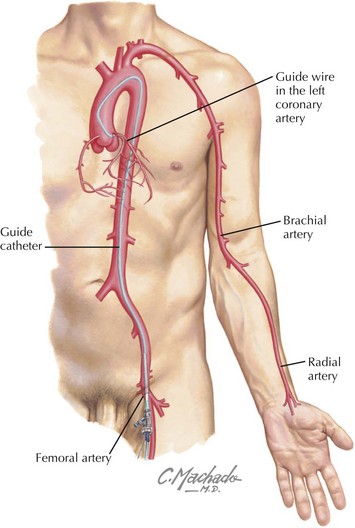Percutaneous coronary intervention PCI commonly known as coronary angioplasty or simply angioplasty is a non-surgical procedure used to treat the stenotic narrowed coronary arteries of the heart found in coronary heart disease. A balloon catheter is then passed and inflated across a narrowing to expand the lumen.
 A Practical Approach To The Management Of Complications During Percutaneous Coronary Intervention Sciencedirect
A Practical Approach To The Management Of Complications During Percutaneous Coronary Intervention Sciencedirect
When coronary artery disease causes chest pain or a heart attack percutaneous coronary interventions such as angioplasty alone or with a stent can restore blood flow to your heart.

What is percutaneous coronary intervention. Percutaneous coronary intervention is a non-surgical method used to open narrowed arteries that supply heart muscle with blood coronary arteries. The catheter is passed until it reaches the coronary arteries of the heart. PCI requires cardiac catheterization which is the insertion of a catheter tube and injection of contrast dye usually iodine-based into your coronary.
The combination of coronary angioplasty with stenting is usually referred to as percutaneous coronary intervention PCI. Percutaneous means through unbroken skin Percutaneous coronary intervention is performed by inserting a catheter through the skin in the groin or arm into an artery. Percutaneous Coronary Intervention PCI is a treatment used to treat narrowed or blocked arteries and increase blood flow to heart muscle.
PTCA is now referred to as percutaneous coronary intervention or PCI as this term includes the use of balloons stents and atherectomy devices. Percutaneous coronary intervention PCI also known as coronary angioplasty is a nonsurgical procedure that improves blood flow to your heart. When a coronary angioplasty is used Like all organs in the body the heart needs a constant supply of blood.
The preparation and procedure for PCI can be similar to the angiogram and is performed in the cardiac catheterisation lab immediately following your coronary angiogram or as a separate PCI procedure. Also known as Coronary Angioplasty. In a PCI doctors perform angioplasty a procedure to repair or open a blood vessel and place stents tiny metal mesh tubes inserted into blood vessels to keep them open.
Percutaneous Coronary Intervention PCI formerly known as angioplasty with stent is a non-surgical procedure that uses a catheter a thin flexible tube to place a small structure called a stent to open up blood vessels in the heart that have been narrowed by plaque buildup a condition known as atherosclerosis. Our doctors use the latest tools and techniques to reduce your recovery time. A Percutaneous Coronary Intervention PCI also known as a coronary angioplasty usually with stent insertion is a technique which widens the narrowed arteries in the heart and squashes the fatty tissue.
Percutaneous Coronary Intervention is the insertion of catheters into arteries in wrist or groin. Percutaneous coronary intervention is accomplished with a small balloon catheter inserted into an artery in the groin or wrist and advanced to the narrowing in the coronary artery. Percutaneous coronary intervention PCI is a minimally invasive procedure that opens narrowed or blocked coronary heart arteries.
Our doctors use the latest tools and techniques to reduce your recovery time. When coronary artery disease causes chest pain or a heart attack percutaneous coronary interventions such as angioplasty alone or with a stent can restore blood flow to your heart. Percutaneous coronary intervention PCI also known as coronary angioplasty is a nonsurgical technique for treating obstructive coronary artery disease including unstable angina acute.
The National Service Framework for Coronary Heart Disease Department of Health 2000 identified a need to double the number of these procedures carried out per year by 2010 to provide a service comparable with the rest of western Europe. Sometimes referred to as coronary angioplasty. This is supplied by the coronary arteries.
Percutaneous transluminal coronary angioplasty PTCA has been found effective for relieving some of these symptoms RITA-2 trial participants 1997. About Percutaneous Coronary Intervention Percutaneous coronary intervention is a medical procedure performed to open blocked coronary arteries caused by coronary artery disease and to restore arterial blood flow to the heart tissue without open-heart surgery.
 Percutaneous Coronary Intervention Wikipedia
Percutaneous Coronary Intervention Wikipedia
 Advancements In Percutaneous Coronary Intervention Market For Prevention And Treatment With Evolving Cagr Of 10 8 In The Healthcare Industry Through 2017 2023 Medgadget
Advancements In Percutaneous Coronary Intervention Market For Prevention And Treatment With Evolving Cagr Of 10 8 In The Healthcare Industry Through 2017 2023 Medgadget
 Myocardial Infarction Due To Percutaneous Coronary Intervention Nejm
Myocardial Infarction Due To Percutaneous Coronary Intervention Nejm

 Percutaneous Coronary Intervention Pci Coronary Angioplasty And Stent Placement
Percutaneous Coronary Intervention Pci Coronary Angioplasty And Stent Placement
 Percutaneous Coronary Intervention Pci Rodnie Oro
Percutaneous Coronary Intervention Pci Rodnie Oro
 Percutaneous Coronary Intervention Market Is Poised For An Explosive Cagr Of 10 8 Through The Forecast Period 2017 2023 Medgadget
Percutaneous Coronary Intervention Market Is Poised For An Explosive Cagr Of 10 8 Through The Forecast Period 2017 2023 Medgadget
 A Procedure Of Percutaneous Coronary Intervention Pci Or Coronary Download Scientific Diagram
A Procedure Of Percutaneous Coronary Intervention Pci Or Coronary Download Scientific Diagram

 Percutaneous Coronary Intervention Thoracic Key
Percutaneous Coronary Intervention Thoracic Key
 Percutaneous Coronary Intervention Pci Angioplasty Stents Complications
Percutaneous Coronary Intervention Pci Angioplasty Stents Complications
 Percutaneous Coronary Intervention Coronary Angioplasty Youtube
Percutaneous Coronary Intervention Coronary Angioplasty Youtube
 Learning About Percutaneous Coronary Intervention Healthlink Bc
Learning About Percutaneous Coronary Intervention Healthlink Bc
 Percutaneous Coronary Intervention
Percutaneous Coronary Intervention
Comments
Post a Comment